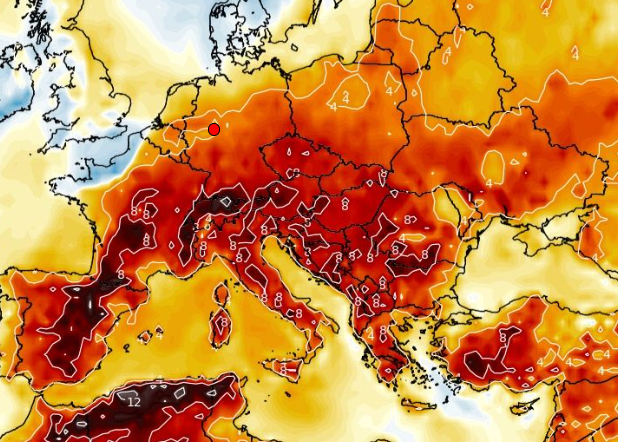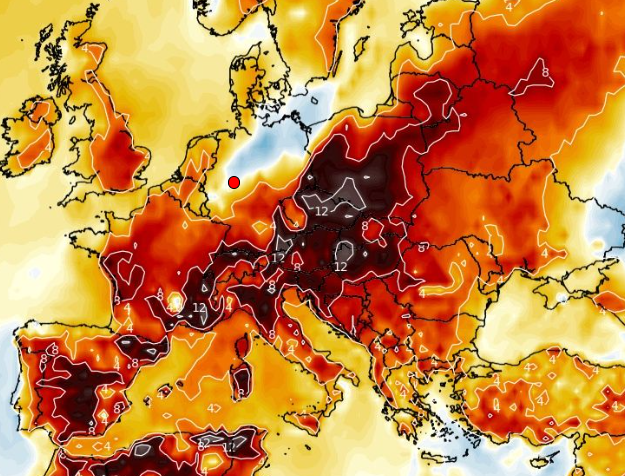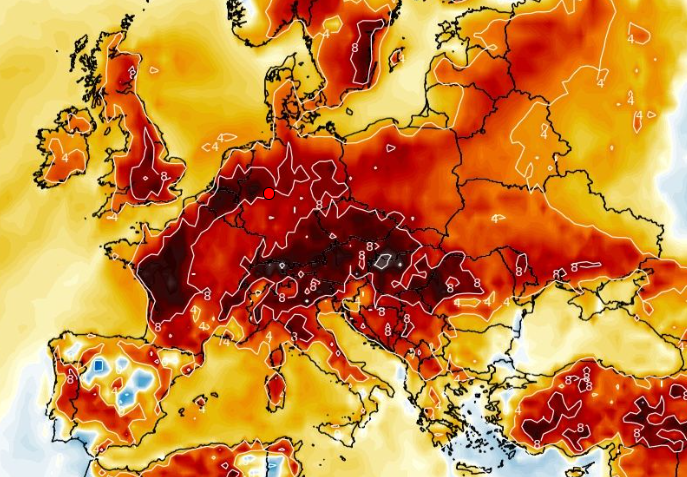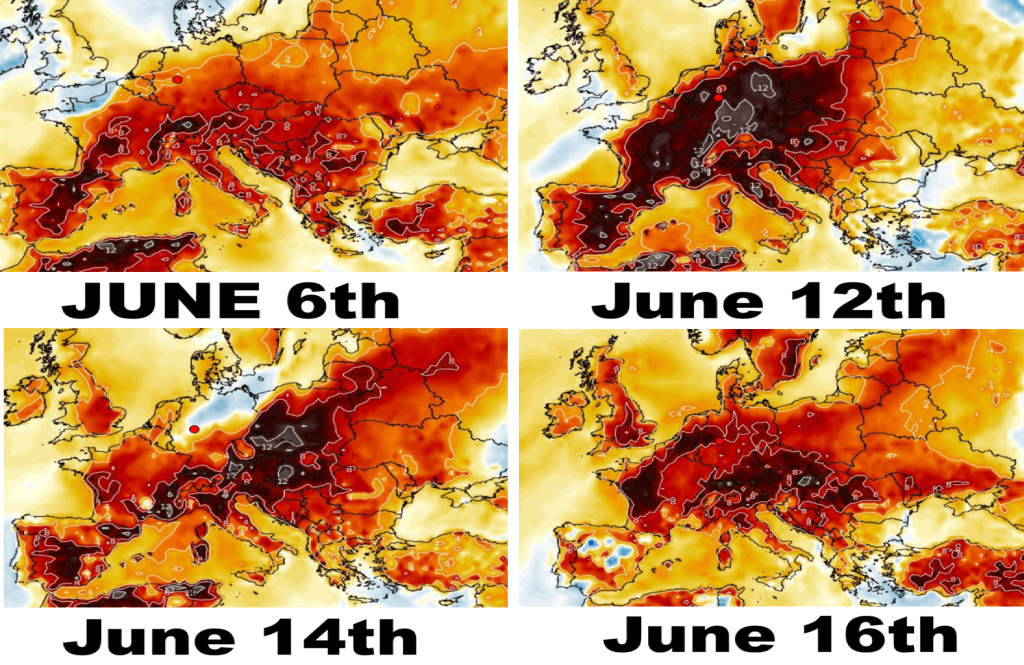
Europe is bracing for an unprecedented early-summer heatwave, with forecasts indicating record-breaking temperatures across the continent in early to mid-June 2025. The Global Forecast System (GFS) ensemble models from Wetterzentrale suggest that this could be the most intense heatwave ever recorded so early in the season, with significant implications for public health, infrastructure, and the environment.
From the last extremes
In Spain, El Granado recorded a staggering 41.6°C on May 30, 2025, marking the highest May temperature ever documented in the country. Similarly, Seville reached 40.1°C on May 29, just 0.9°C below Spain’s all-time May record.
Portugal also faced extreme heat, with Coruche and Alvega both hitting 39.9°C on May 29, narrowly missing the national May record by 0.1°C. Amareleja matched the highest May temperature ever recorded in the country at 39.5°C.
France experienced unprecedented temperatures as well. Bégaar set a new May record with 37.0°C, while Canet-en-Roussillon reached 32.3°C.
Over the past 48 hours, Europe has experienced significant temperature extremes, particularly in the Iberian Peninsula and parts of France. These events have been documented by the X account Extreme Temperatures Around The World.
🔥 Notable High Temperatures
- Amareleja, Portugal: Reached 39.5°C, matching the country’s highest May temperature on record.
- El Granado, Spain: Recorded 39.1°C.
- Canet-en-Roussillon, France: Peaked at 32.3°C.
- Badajoz Airport, Spain: Reported 39.2°C, setting a new record.
- Cáceres, Spain: Reached 37.1°C, also a new record.
Record High Minimum Temperatures
- Tarifa, Spain: Experienced a minimum temperature of 20.4°C, marking a new record for the highest minimum temperature.
Extreme scenarios are fullfilling
The upcoming forecast will reveal the most extreme temperature scenarios expected across European countries up to mid-June 2025. Using the hottest 850 hPa ensemble run and adding 17°C to estimate maximum surface temperatures, southern Europe will face the greatest heat risks. Countries such as Spain, Portugal, Italy, Greece, and Cyprus will potentially experience soaring temperatures reaching up to 42°C, marking conditions that could trigger severe heatwaves.
Central European nations—including France, Hungary, Romania, and Austria—will likely see daytime highs climbing into the high 30s Celsius, with maximum temperatures around 36–39°C. Such intense heat will put considerable stress on public health systems, agriculture, and infrastructure. Meanwhile, northern European countries such as Sweden, Norway, Finland, and the UK will generally experience more moderate extremes, with maximum temperatures expected to stay below 33°C, though still unusually warm for those regions.
Recommendations during heatwaves
Heatwaves represent a significant health and environmental hazard, especially during extreme and prolonged periods of high temperatures. Elderly people are among the most vulnerable because their bodies often struggle to regulate temperature effectively. Age-related conditions and medications can impair their ability to sweat and cool down, increasing the risk of heat exhaustion, heatstroke, and dehydration, which can be life-threatening without prompt care.
Individuals with chronic illnesses—such as cardiovascular disease, diabetes, respiratory problems, or kidney issues—are also at heightened risk during heatwaves. Their conditions can worsen as extreme heat places additional strain on the heart and lungs. Moreover, some medications can interfere with the body’s heat response, further increasing vulnerability.
Young children face distinct risks as well. Their smaller body mass and developing thermoregulatory systems make it harder for them to maintain safe body temperatures. They can rapidly become dehydrated and suffer from heat-related illnesses if exposed to high heat for extended periods, especially without adequate hydration or cooling.
Animals, including household pets and livestock, are equally susceptible to heat stress. Pets may not be able to escape hot environments or communicate discomfort effectively, leading to heatstroke and, in severe cases, death. Livestock exposed to extreme heat without sufficient shade, water, or ventilation may suffer from reduced productivity, illness, or mortality, which also impacts food supply and farming livelihoods.
Plants and crops are vulnerable to heatwaves, especially when heat coincides with drought conditions. Excessive heat can cause wilting, reduce photosynthesis efficiency, and even lead to plant death if water is insufficient. This not only affects home gardens but can also threaten food security by damaging agricultural yields and disrupting ecosystems.
Property and infrastructure face multiple risks during heatwaves. Asphalt and roads can soften or crack, increasing maintenance needs and hazards for transportation. Power grids often experience peak demand due to air conditioning use, risking blackouts or brownouts. High temperatures also elevate the risk of wildfires, threatening homes, forests, and natural habitats. Buildings can suffer damage from heat expansion and increased cooling costs can strain household budgets.
Staying well-hydrated, avoiding outdoor exertion during the hottest parts of the day, using fans or air conditioning safely, and checking on vulnerable neighbors and family members are important. Pets should have constant access to water and cool resting places. Plants need adequate watering and protection from direct sun. Communities and governments should prepare by ensuring emergency services are ready and infrastructure is resilient.
Temperature anomalies according to the last run of GFS from 1.6. 2025 for selected days ahead
6. June 2025

12. – 14. June 2025



16. June 2025

The estimated national maximum temperatures in the first half of June 2025 according to current runs according to hot scenarios of ensemble runs
Based on the latest 850 hPa ensemble forecasts from Wetterzentrale, we can estimate potential maximum surface temperatures across various European countries. By adding approximately 17°C to the 850 hPa temperatures from the hottest ensemble members, we obtain a rough approximation of national high temperatures under sunny and dry conditions.
Most Extreme Temperature Scenario Forecast (up to mid-June 2025)
| Country | Hottest 850 hPa Temp (°C) | Estimated Max Surface Temp (°C) |
|---|---|---|
| Spain | +25 | ~42°C |
| Portugal | +24 | ~41°C |
| France | +22 | ~39°C |
| Italy | +23 | ~40°C |
| Greece | +24 | ~41°C |
| Bulgaria | +23 | ~40°C |
| Romania | +22 | ~39°C |
| Hungary | +21 | ~38°C |
| Slovakia | +21 | ~38°C |
| Austria | +21 | ~38°C |
| Czech Republic | +20 | ~37°C |
| Germany | +19 | ~36°C |
| Belgium | +19 | ~36°C |
| Netherlands | +19 | ~36°C |
| Luxembourg | +19 | ~36°C |
| Switzerland | +20 | ~37°C |
| Ukraine | +21 | ~38°C |
| Belarus | +20 | ~37°C |
| Poland | +19 | ~36°C |
| UK | +16 | ~33°C |
| Ireland | +15 | ~32°C |
| Denmark | +16 | ~33°C |
| Sweden | +13 | ~30°C |
| Norway | +12 | ~29°C |
| Finland | +12 | ~29°C |
| Estonia | +14 | ~31°C |
| Latvia | +15 | ~32°C |
| Lithuania | +16 | ~33°C |
| Malta | +22 | ~39°C |
| Cyprus | +24 | ~41°C |
| Iceland | +8 | ~25°C |

Illustration photo: https://www.hdwallpapers.in/trees_forest_during_sunset_under_black_yellow_clouds_sky_4k_hd_nature-wallpapers.html



























